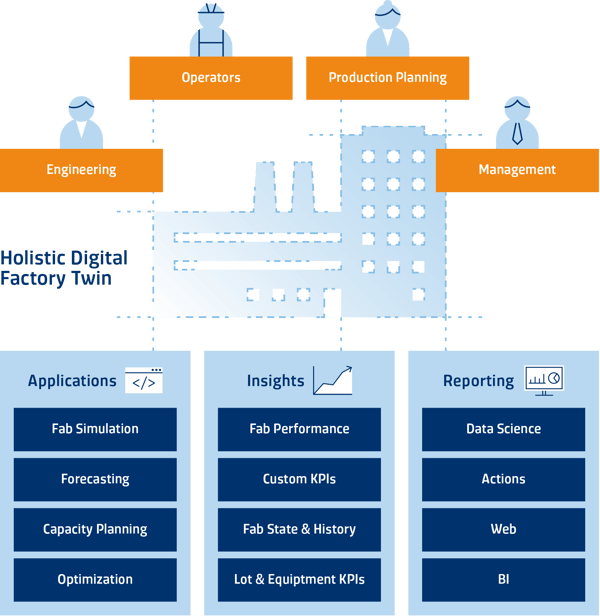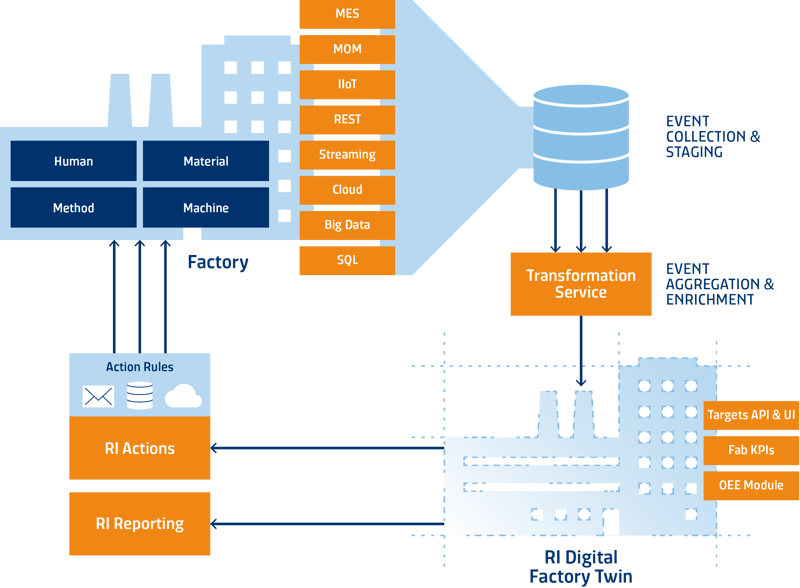What is SYSTEMA’s Real-Time Intelligence Suite (RI Suite)?
The manufacturing domain is – even in the age of “Big data” and “Industry 4.0” – often characterized by seemingly avoidable issues:
- too many variables, alarms, dashboards
- disparate data sources
- conflicting, overlapping information
- no real-time information
- no data drill-down capabilities
- no root cause and historical analysis capabilities
SYSTEMA addresses these challenges by providing a coherent data integration solution that puts the needs of users into the spotlight.
SYSTEMA’s Real-Time Intelligence Suite (RI Suite) is an event-driven, integrated, scalable, real-time digital factory twin solution for up-to-date factory analytics, reporting, and optimization. It implements a discrete manufacturing model and provides a single point of truth for manufacturing intelligence. While being generic in nature, the model is in particular tuned to the needs of semiconductor front-end production. Because of its intrinsic holistic structure, the solution enables drill-down and root cause analysis across all main actors including material, method, human, and machine (4M).

Figure 1: The RI Suite simplifies and consolidates all factory events in a centralized digital factory twin model
On top of its holistic digital twin representation, it allows the creation of applications to increase factory transparency as well as to improve the production process.
What problems does it solve?
RI Suite was created with different user groups in mind, such as operators, engineers, and production management. These groups face different challenges in their everyday work and require data transparency to be able to make decisions that can vary from short to long-term but also involve strategic considerations. Via SQL compliant interface, RI Suite integrates with all major BI solutions and is thus democratizing factory intelligence to answer a wide variety of questions relating to the current state and history of material, methods, humans, and machines.
Benefits
Save time using an integrated real-time interface for all the data sources in your factory
Enable administrators, operators and management to gain deep insights into your factory processes
Increase transparency using an interactive shop floor interface
Solve problems efficiently with anomaly detection & event classification
Monitor factory health in real-time with automatic data aggregation & KPI dashboards
Understand log events with enriched context information
Some scenarios where RI Suite can support
- An operator checks what is happening on their shift and needs up-to-date data for say up to the last 5 mins. They will be targeting a small number of machines and need to know which machine is running optimally and which machine is lagging.
- A technician who is inspecting machines he is responsible for, typically targeting all the machines of a certain brand – all die bonders for example – and needs up-to-date data within the last 5 mins.
- An engineer overseeing the performance of their area of responsibility wants to see the performance of last week or last month. They are interested in trends, heat maps, and comparisons between the best and worst machine might be needed, although each machine should be performing the same.
- An engineering manager is looking for the overall performance of all the assembly equipment to find out whether recent improvements are working. Do the OEE figures correspond to planning figures?
- Production/operation management wants to understand the overall metrics of the site to understand where they lose capacity or if the machine to operator ratio is right. They might want to know if the overall usage of OEE is consistent – and of meaningful granularity (i.e., product/group-specific).
RI Suite provides different functional modules to facilitate such use-cases
Real-time interface to control effectiveness of production at the shift level
- Drill-down into equipment and material adhering to the 4M approach (material, method, human, and machine)
- Define and visualize target fulfillments
A digital twin of the factory to enable root cause and production health analytics
- Comparative analysis between equipment types
- Drill-down into the different components of OEE to single equipment, manufacturing execution system (MES), and operator events
- Alarm monitoring, aggregation, equipment drill-down, and trigger for corrective actions
Current operational status and fab health to support production planning
- Track availability of equipment and material and map to targets
- Improve capability to always deliver on time with optimized scheduling and real-time updates
Best transparency of production and productivity fulfillment
- Real-time updates on production fulfilments
- Alerts in case of severe target violations
- Real-time, bird’s-eye view of factory OEE with drill-down capabilities
How does it work?
RI Suite allows both, frontend and backend fabs, those with potential in automation as well as highly automated facilities, to break up data silos and disparate sources of information. Its scalable ingest path feeds a transformation service that provides complex event processing including event archiving and mapping. It handles validation, abstraction (aggregation and transformation), maintains the model event hierarchies, and detects relationships between events (such as causality, membership, or timing). In addition, the transformation service applies rules to the RI model including model-based event validation, data preparation, and data enrichment. As a result, initially disparate event data sources are consolidated into an integrated, high-quality digital factory twin data model.

Figure 2: Data ingest options of the RI Suite
Second, RI Suite includes sophisticated algorithms to implement a standardized factory state model based on atomics, fractals, and fundamentals.
- Atomics represent single events that are considered within the domain model and hold information for the fundamental or fractal components.
The purpose of the atomics is to collect all raw data with keys in historical order. - Fundamentals are the first aggregation tier of the holistic information model that collates the information of several events into information components. Fundamentals record time intervals of transactions, such as from operation start to operation end.
- Fractals integrate any dynamic change or movement of objects into finite, countable elements. Fractals add another layer of granularity by creating time slices with hourly resolution and detection.
Based on this data pre-aggregation model, RI Suite maximizes KPI query performance. WIP maps, OEE, and lot histories are no longer queried in hours – these insights are now available within seconds.
What’s in the box?
RI Suite ships with all ingredients to establish reporting, transparency, and optimization on the shop floor using an event-driven factory state model.
- In close collaboration with our customers, we first work out data sources and establish an ingest path into a temporary event store called Stage Database. Data can be ingested from a wide range of inputs including MES, databases, IIoT, or message-oriented middleware.
- The transformation service aggregates and enriches events and populates the RI Reporting database
- A target system allows for the definition and specification of KPI targets
- A huge analytical toolbox contains dozens of factory KPIs in the RI Reporting Database to provide insights into the current state as well as the history of the factory including throughput, WIP, cycle time, flow factor, yield/quality, and OEE.
- Additional applications enable forecasting and planning functionality in conjunction with other systems (such as EDDi)
- A reporting front-end provides a fresh web interface to use the RI suite without additional BI tooling
- A configurable actions service allows for automatic tracking of target violations, data quality, data integrity, and other scheduled reporting tasks.
Licensing
RI Suite is offered as a licensed software product, configured and run on-premise, with options for maintenance and support contracts based upon individual factory needs.
SYSTEMA provides training, and, if needed, services to deliver a fully digital factory twin that is integrated with a manufacturing environment’s existing IT systems, including integration with the MES shop-floor user interface, or SYSTEMA’s shop-floor UI. Turnkey projects typically take 4 to 8 weeks to establish a mapping from event sources into the RI data model, and range from 3 to 12 months duration for complete end-user deployment, depending on the complexity of the existing IT infrastructure, and operational and manufacturing processes.
For additional information, or if you would like to schedule a demo or a workshop to discuss how to enable transparency and optimization in discrete manufacturing, please contact us and we will follow up with you directly.
Why SYSTEMA?
SYSTEMA specializes in supporting semiconductor manufacturers in achieving the IT capabilities necessary to address the needs of the complete semiconductor value chain – from wafering to front-end through to back-end assembly and test. For 30 years, SYSTEMA has developed and implemented solutions designed around the unique requirements of semiconductor manufacturers where rapidly changing market conditions and customer requirements drive them to constantly expand product offerings, focus on individualization and mass customization with “lot size one” options, and excel at just-in-time delivery.
At SYSTEMA, we understand the risks and challenges that come along with implementing automation solutions on the shop floor. We provide training, consulting, and successful implementation of smart manufacturing solutions and customization of functionality with end-users in mind. In doing so, we empower users to independently leverage and manage the capabilities of their systems.
